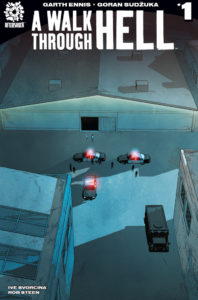 A Walk Through Hell #1 — Writer: Garth Ennis; Art: Goran Sudzuka; Colors: Ive Svorcina
A Walk Through Hell #1 — Writer: Garth Ennis; Art: Goran Sudzuka; Colors: Ive Svorcina
World of Tanks: Citadel #1 (of 5) — Writer: Garth Ennis; Art: P.J. Holder; Colors: Michael Atiyeh
Flavor #1 — Writer: Joseph Keating; Art: Wook Jin Clark; Colors: Tamra Bonvillain
Ether #1 — Writer: Matt Kindt; Art: David Rubin; Colors: Kike J. Diaz
Let’s start with the indy titles this week, since both the quantity (15 books on this list!) and the quality (Ennis, Kindt, Lemire, Vaughan, Millar, Gillen, Mignola, Sakai and Alan Moore, just to name the  writers) are high, First up are two debuts from Garth Ennis: A Walk Through Hell sees him in full Dread Mode — and, while the author of Preacher, The Boys and Crossed, among others, can certainly do in-your-face horror gross-outs, here he’s playing a subtler, longer game, dropping hints of terrible things while only showing a little (well, a little for him), turning the screws and daring us to come back and face the consequences in the next issue. If you’re any kind of occult/horror fan, pick this up and see if you aren’t hooked. Ennis’s other book showcases another passion: war comics, using the World of Tanks videogame to offer another deeply-researched, clear-eyed and compassionate WWII tale, this time about the Battle of Kursk, with Russian and German tank crews battling it out during
writers) are high, First up are two debuts from Garth Ennis: A Walk Through Hell sees him in full Dread Mode — and, while the author of Preacher, The Boys and Crossed, among others, can certainly do in-your-face horror gross-outs, here he’s playing a subtler, longer game, dropping hints of terrible things while only showing a little (well, a little for him), turning the screws and daring us to come back and face the consequences in the next issue. If you’re any kind of occult/horror fan, pick this up and see if you aren’t hooked. Ennis’s other book showcases another passion: war comics, using the World of Tanks videogame to offer another deeply-researched, clear-eyed and compassionate WWII tale, this time about the Battle of Kursk, with Russian and German tank crews battling it out during  the summer of 1942, with totals of almost three million men and eight thousand tanks. Flavor goes in a much more manga-esque direction; it’s about a girl in a vaguely steampunk/magical society who’s trying to run her parents’ restaurant after they’ve become disabled — but the bureaucracy requires that, since she’s an unlicensed chef, her adult uncle come to town and help her, and if they can’t make it work her family will be shattered; there are also swords, a hyper-intelligent dog, monsters and other hints of a much wider world, but the book’s hook, and main focus, looks like it will be on the cooking. This is one of those books where the first issue takes most of its space to introduce the characters and set up the premise, but the story is told well enough to bring us back for the
the summer of 1942, with totals of almost three million men and eight thousand tanks. Flavor goes in a much more manga-esque direction; it’s about a girl in a vaguely steampunk/magical society who’s trying to run her parents’ restaurant after they’ve become disabled — but the bureaucracy requires that, since she’s an unlicensed chef, her adult uncle come to town and help her, and if they can’t make it work her family will be shattered; there are also swords, a hyper-intelligent dog, monsters and other hints of a much wider world, but the book’s hook, and main focus, looks like it will be on the cooking. This is one of those books where the first issue takes most of its space to introduce the characters and set up the premise, but the story is told well enough to bring us back for the  two or three next chapters, at least. Ether is more of a known quantity; it’s the second volume of a series about a science-oriented adventurer who’s stumbled onto a fantasy world, and solves their magical problems (all together now: with science!) while dealing with the fact that, because time passes quicker there, every time he returns to Earth he’s been gone for years, but only aged a little, and so is out of synch with any remaining family and friends. Kindt’s worked out a bunch of other ramifications, too, so it’s a combo of Sherlock Holmes and Lord of the Rings, with a dab of “Rip Van Winkle”; if any of that sounds intriguing, you’re probably the audience for this book.
two or three next chapters, at least. Ether is more of a known quantity; it’s the second volume of a series about a science-oriented adventurer who’s stumbled onto a fantasy world, and solves their magical problems (all together now: with science!) while dealing with the fact that, because time passes quicker there, every time he returns to Earth he’s been gone for years, but only aged a little, and so is out of synch with any remaining family and friends. Kindt’s worked out a bunch of other ramifications, too, so it’s a combo of Sherlock Holmes and Lord of the Rings, with a dab of “Rip Van Winkle”; if any of that sounds intriguing, you’re probably the audience for this book.
 Barrier #3 (of 5) — Writer: Brian K. Vaughan; Art: Marcos Martin; Colors: Muntsa Vicente
Barrier #3 (of 5) — Writer: Brian K. Vaughan; Art: Marcos Martin; Colors: Muntsa Vicente
Dead Hand #2 — Writer: Kyle Higgins; Art: Stephen Mooney; Colors: Jordie Bellaire
Kick-Ass #4 — Writer: Mark Millar; Pencils: John Romita Jr.; Inks/Colors: Peter 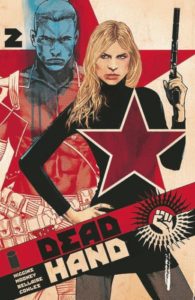 Steigerwald
Steigerwald
Gideon Falls #3 — Writer: Jeff Lemire; Art: Andrea Sorrentino; Colors: Dave Stewart
Hungry Ghosts #4 — Writers: Anthony Bourdain and Joel Rose; Art: Irene Koh and Francesco Francavilla
Assassinistas #5 (of 6) — Writer: Tini Howard; Art: Gilbert Hernandez
Of the recently-launched, newer series, Barrier is the youngest — its first two issues came out just last week — but 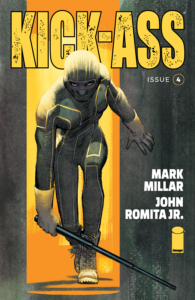 also older, since it was originally a digital-first comic a few years ago; that accounts for its sideways, widescreen format, which is (a) annoying to obsessive collectors, and (2) very good at showing off Marcos Martin’s clear-lined art, and Muntsa Vicente’s vivid colors. Since it’s by Brian K. Vaughan, it’s consistently well-written and surprising, too: this issue is silent, as its two protagonists, having been separately kidnapped by an alien spaceship and now in outer space, have been rendered deaf, and so have to communicate by gestures and expressions — all of which plays to Martin’s strengths in expression and simple composition. Vaughan’s ability to send the plot off in unexpected directions pays off, and this is a good-
also older, since it was originally a digital-first comic a few years ago; that accounts for its sideways, widescreen format, which is (a) annoying to obsessive collectors, and (2) very good at showing off Marcos Martin’s clear-lined art, and Muntsa Vicente’s vivid colors. Since it’s by Brian K. Vaughan, it’s consistently well-written and surprising, too: this issue is silent, as its two protagonists, having been separately kidnapped by an alien spaceship and now in outer space, have been rendered deaf, and so have to communicate by gestures and expressions — all of which plays to Martin’s strengths in expression and simple composition. Vaughan’s ability to send the plot off in unexpected directions pays off, and this is a good- looking package that packs a powerful punch. Dead Hand is on the same wavelength: its first issue ended on a classic killer plot twist, and damned if this second one doesn’t, too; Stephen Mooney’s got a flair for action/suspense art that reminds me of Mike Grell (especially on one formally-composed double-page splash here), and this offers a brisk, smart read. Kick-Ass has some of that same smooth professionalism; Mark Millar’s always had his thumb four-square on the pulse of pop culture, so it’s no surprise that this #MeToo-era version of the character is a single-mother veteran, or that John Romita Jr. handles all the cliffhanger action so effortlessly that we forgive any small plot
looking package that packs a powerful punch. Dead Hand is on the same wavelength: its first issue ended on a classic killer plot twist, and damned if this second one doesn’t, too; Stephen Mooney’s got a flair for action/suspense art that reminds me of Mike Grell (especially on one formally-composed double-page splash here), and this offers a brisk, smart read. Kick-Ass has some of that same smooth professionalism; Mark Millar’s always had his thumb four-square on the pulse of pop culture, so it’s no surprise that this #MeToo-era version of the character is a single-mother veteran, or that John Romita Jr. handles all the cliffhanger action so effortlessly that we forgive any small plot  shortcuts (hydrogen balloons? seriously?). Gideon Falls is Jeff Lemire working the Lovecraftian looming-dread genre, like Ennis in A Walk in Hell; the focal point is a sinister black barn that keeps trying to manifest itself, and its terrible inhabitant. Andrea Sorrentino and Dave Stewart make it all suitably shadowy and paranoid/atmospheric, while the protagonist demonstrates that it’s not really obsessive-compulsive disorder or hoarding if there actually is a vast occult conspiracy that you’re fighting. Hungry Ghosts is Anthony Bourdain collaborating with various artists in retelling Japanese horror folk tales; Irene Koh has a good-looking
shortcuts (hydrogen balloons? seriously?). Gideon Falls is Jeff Lemire working the Lovecraftian looming-dread genre, like Ennis in A Walk in Hell; the focal point is a sinister black barn that keeps trying to manifest itself, and its terrible inhabitant. Andrea Sorrentino and Dave Stewart make it all suitably shadowy and paranoid/atmospheric, while the protagonist demonstrates that it’s not really obsessive-compulsive disorder or hoarding if there actually is a vast occult conspiracy that you’re fighting. Hungry Ghosts is Anthony Bourdain collaborating with various artists in retelling Japanese horror folk tales; Irene Koh has a good-looking 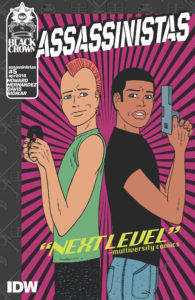 regular-manga style in her piece (also the subject of the Paul Pope cover, up to the left there; click on it for a larger version), but the real attraction is Francesco Francavilla, who offers a slow build to a blow-out-the-stops conclusion in his story about cannibalism, vampires and why some people deserve one or the other. Assassinistas continues to be a showcase for Gilbert Hernandez’s always-perfect art, but reading this penultimate issue reminds us how much Tini Howard’s story has helped, too; on the editorial page, she lists her influences as Kill Bill, The Venture Brothers and the Go-Gos’ first album, among others — not to mention Love and Rockets itself — so it’s not surprising that her collaboration with Hernandez has proved so energetically compatible.
regular-manga style in her piece (also the subject of the Paul Pope cover, up to the left there; click on it for a larger version), but the real attraction is Francesco Francavilla, who offers a slow build to a blow-out-the-stops conclusion in his story about cannibalism, vampires and why some people deserve one or the other. Assassinistas continues to be a showcase for Gilbert Hernandez’s always-perfect art, but reading this penultimate issue reminds us how much Tini Howard’s story has helped, too; on the editorial page, she lists her influences as Kill Bill, The Venture Brothers and the Go-Gos’ first album, among others — not to mention Love and Rockets itself — so it’s not surprising that her collaboration with Hernandez has proved so energetically compatible.
 The Wicked and the Divine #36 — Writer: Kieron Gillen; Art: Jamie McKelvie; Colors: Matthew Wilson
The Wicked and the Divine #36 — Writer: Kieron Gillen; Art: Jamie McKelvie; Colors: Matthew Wilson
Moonshine #10 — Writer: Brian Azzarello; Art/Colors: Eduardo Risso
B.P.R.D.: The Devil You Know #6 — Writers: Mike Mignola and Scott Allie; Art: Sebastian Fiumara with Mike Mignola; Colors: Dave Stewart
 Cinema Purgatorio #14 — Creators: Various
Cinema Purgatorio #14 — Creators: Various
Usagi Yojimbo: The Hidden #3 (of 7) — Creator: Stan Sakai
Of the longer-established titles, The Wicked and the Divine is rocketing towards its conclusion, but takes some time out: the first twelve pages are 66 panels showing the same point in the story’s 90-year cycle — when Ananke “kills” Persephone — at every date from 3862 BC on up; the small 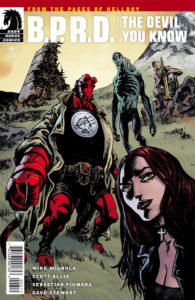 differences, plus the fashion details, are both obsessive and amazing (Gillen talks about all the research required in the editorial material, and one can only imagine how artist McKelvie felt about it, but the result is worth it). That’s all just prologue to the ramifications of a major reveal last issue, though; if you’ve been a fan of this book from the beginning, you should be very happy right now, and if you’ve never read it… well, don’t start here: you have six trades’ worth of high-quality storytelling to get caught up on first. Moonshine has a
differences, plus the fashion details, are both obsessive and amazing (Gillen talks about all the research required in the editorial material, and one can only imagine how artist McKelvie felt about it, but the result is worth it). That’s all just prologue to the ramifications of a major reveal last issue, though; if you’ve been a fan of this book from the beginning, you should be very happy right now, and if you’ve never read it… well, don’t start here: you have six trades’ worth of high-quality storytelling to get caught up on first. Moonshine has a  payoff, too, but at the very end: you can’t write a werewolf story without some fangs and claws, after all, although that’s hardly missed in the rest of the issue, as watching Eduardo Risso draw Southern chain gangs is entertainment enough. B.P.R.D.: The Devil You Know has an even bigger payoff: Hellboy back in the real world, and the first three pages of the issue drawn by Mike Mignola himself; if that doesn’t get you to pick it up, you never will. Cinema Purgatorio’s Alan Moore/Kevin O’Neill offering this issue is a tutorial about
payoff, too, but at the very end: you can’t write a werewolf story without some fangs and claws, after all, although that’s hardly missed in the rest of the issue, as watching Eduardo Risso draw Southern chain gangs is entertainment enough. B.P.R.D.: The Devil You Know has an even bigger payoff: Hellboy back in the real world, and the first three pages of the issue drawn by Mike Mignola himself; if that doesn’t get you to pick it up, you never will. Cinema Purgatorio’s Alan Moore/Kevin O’Neill offering this issue is a tutorial about  the career of movie director Tod Browning (Freaks, not to mention Dracula); as always, it’s both educational and disturbing. Of the other series in this anthology, the best continues to be Code Pru, by Garth Ennis (him again!) and with detailed, pretty black-and-white art by Raulo Caceres — although with other stories by Kieron Gillen, Max Brooks and Christos Gage, there’s plenty of quality to go around. That leaves Usagi Yojimbo, always the perfect chaser; Stan Sakai’s rabbit ronin has, after all these decades, achieved his own level of precise storytelling bliss, as this arc, co-starring Inspector Ishida and touching on the persecution of Christians in feudal Japan, demonstrates.
the career of movie director Tod Browning (Freaks, not to mention Dracula); as always, it’s both educational and disturbing. Of the other series in this anthology, the best continues to be Code Pru, by Garth Ennis (him again!) and with detailed, pretty black-and-white art by Raulo Caceres — although with other stories by Kieron Gillen, Max Brooks and Christos Gage, there’s plenty of quality to go around. That leaves Usagi Yojimbo, always the perfect chaser; Stan Sakai’s rabbit ronin has, after all these decades, achieved his own level of precise storytelling bliss, as this arc, co-starring Inspector Ishida and touching on the persecution of Christians in feudal Japan, demonstrates.
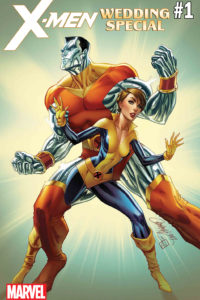 X-Men: The Wedding Special #1 (of 1) — Creators: Various
X-Men: The Wedding Special #1 (of 1) — Creators: Various
Quicksilver: No Surrender #1 (of 5) — Writer: Saladin Ahmed; Art: Eric Nguyen; Colors: Rico Renzi
Mighty Thor: At the Gates of Valhalla #1 (of 1) — Writer: Jason Aaron; Art: Jen Bartel and Ramon Perez; Colors: Matthew Wilson
The Claws of a Killer #1 (of 4) — Writer: Mariko Tamaki; Pencils: Butch Guice; Inks: Cam Smith; Colors: Dan Brown
Avengers #2 (#692) — Writer: Jason Aaron; Pencils: Ed 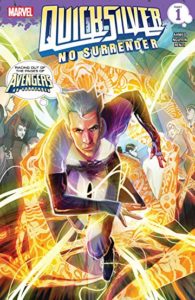 McGuinness; Inks: Mark Morales with Jay Leisten; Colors: David Curiel
McGuinness; Inks: Mark Morales with Jay Leisten; Colors: David Curiel
Captain America #702 — Writer: Mark Waid; Art: Leonardo Romero with Rod Reis and Howard Chaykin; Colors: Jordie Bellaire with Rod Reis and Jesus Aburtov
The X-Men Wedding Special lives up to its name with the first Chris Claremont-scripted X-story in quite a while: a Kitty Pryde retrospective drawn by Todd Nauck; since Claremont is Kitty’s co-creator (it’s too bad that Marvel and her other creator, John Byrne, have burned too many bridges for him to show up too), it’s an appropriately thoughtful and affectionate look at her career, and future.  There’s also a bachelor-party story by Marc Guggenheim and Greg Land, and, even better, a bachelorette-party tale by Kelly Thompson, who has Rogue (newly back with Gambit, thanks to Thompson’s just-concluded mini-series about those two) give the bride some relationship advice: that’s a nice combination of old/current/new creators, and it makes for a suitably-celebratory package. Quicksilver starts a mini-series by Saladin Ahmed, whose well-regarded Black Bolt made him a writer worth watching; after running faster than ever as part of that Avengers: No Surrender weekly event, Pietro finds himself stuck in whatever Marvel calls the Speed Force, with the rest of the world motionless statues to him. Of course, something else is moving (otherwise, we’d have five issue of mutant
There’s also a bachelor-party story by Marc Guggenheim and Greg Land, and, even better, a bachelorette-party tale by Kelly Thompson, who has Rogue (newly back with Gambit, thanks to Thompson’s just-concluded mini-series about those two) give the bride some relationship advice: that’s a nice combination of old/current/new creators, and it makes for a suitably-celebratory package. Quicksilver starts a mini-series by Saladin Ahmed, whose well-regarded Black Bolt made him a writer worth watching; after running faster than ever as part of that Avengers: No Surrender weekly event, Pietro finds himself stuck in whatever Marvel calls the Speed Force, with the rest of the world motionless statues to him. Of course, something else is moving (otherwise, we’d have five issue of mutant 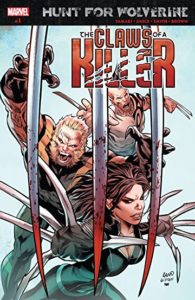 monologuing), and finding out what it is, and why it’s hostile, is the story: so far, it’s an eerie focus on Quicksilver’s psyche, and one that his fans should like. Mighty Thor: At the Gates of Valhalla is a stopgap one-shot between the end of the previous Thundergod series, and the beginning of the new one in a week or two; it’s both an appreciation of the Jane Foster legacy (with some hints about her future) and a preview/setup of the “War of the Realms,” fueled by Dark Elf Malekith, that’s looming as the main plot-driver for the relaunch. Since it’s written by Jason Aaron, the author of both the old and the new series, it’s an integral part of the ongoing Asgard narrative, with enough important plot threads and tributes to keep fans occupied until the Odinson’s return. Claws of a Killer is the third of the four
monologuing), and finding out what it is, and why it’s hostile, is the story: so far, it’s an eerie focus on Quicksilver’s psyche, and one that his fans should like. Mighty Thor: At the Gates of Valhalla is a stopgap one-shot between the end of the previous Thundergod series, and the beginning of the new one in a week or two; it’s both an appreciation of the Jane Foster legacy (with some hints about her future) and a preview/setup of the “War of the Realms,” fueled by Dark Elf Malekith, that’s looming as the main plot-driver for the relaunch. Since it’s written by Jason Aaron, the author of both the old and the new series, it’s an integral part of the ongoing Asgard narrative, with enough important plot threads and tributes to keep fans occupied until the Odinson’s return. Claws of a Killer is the third of the four  “Hunt for Wolverine” mini-series Marvel’s using as a run-up to that character’s own return; it’s Sabertooth, Daken and Lady Deathstrike teaming up to (a) find out if Logan’s alive again, and (b) if so, track him down and kill him. In tone, it’s a horror/mystery book, with Butch Guice’s always-solid superhero art the main attraction. Avengers continues its own relaunch, with a Final Host of Dark Celestials approaching, and a bunch of dead Regular Celestials falling from the skies (you can’t accuse new writer Jason Aaron of not thinking big…). The core trio of Captain America, Iron Man and Thor are back, and supported by Black Panther, She-Hulk, Captain Marvel, Doctor Strange and the Robbie Reyes Ghost Rider, so this issue does its job of getting them (mostly) all together to fight the threat,
“Hunt for Wolverine” mini-series Marvel’s using as a run-up to that character’s own return; it’s Sabertooth, Daken and Lady Deathstrike teaming up to (a) find out if Logan’s alive again, and (b) if so, track him down and kill him. In tone, it’s a horror/mystery book, with Butch Guice’s always-solid superhero art the main attraction. Avengers continues its own relaunch, with a Final Host of Dark Celestials approaching, and a bunch of dead Regular Celestials falling from the skies (you can’t accuse new writer Jason Aaron of not thinking big…). The core trio of Captain America, Iron Man and Thor are back, and supported by Black Panther, She-Hulk, Captain Marvel, Doctor Strange and the Robbie Reyes Ghost Rider, so this issue does its job of getting them (mostly) all together to fight the threat,  ending with a last-panel reveal of a villain who should be familiar to anyone who’s read the very first Avengers, back in 1963. Captain America is in the middle of an arc about how, a century from now, a descendent of Steve Rogers, an historian, uncovers a Kree/US government plot and has to channel — or maybe rescue — his ancestor; besides the regular art from Romero (whose style is close enough to the departed Chris Samnee to effect a smooth transition for readers), there are “historical” sequences by Ivan Reis and, especially, Howard Chaykin, who contributes a five-page Cap/Red Skull battle that’s practically worth the price of admission by itself. Cool “we dare you not to come back next issue” twist, too.
ending with a last-panel reveal of a villain who should be familiar to anyone who’s read the very first Avengers, back in 1963. Captain America is in the middle of an arc about how, a century from now, a descendent of Steve Rogers, an historian, uncovers a Kree/US government plot and has to channel — or maybe rescue — his ancestor; besides the regular art from Romero (whose style is close enough to the departed Chris Samnee to effect a smooth transition for readers), there are “historical” sequences by Ivan Reis and, especially, Howard Chaykin, who contributes a five-page Cap/Red Skull battle that’s practically worth the price of admission by itself. Cool “we dare you not to come back next issue” twist, too.
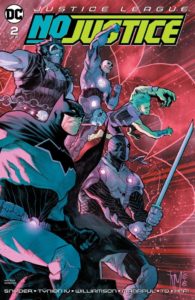 No Justice #2 (of 4) — Writers: Scott Snyder, James Tynion IV and Joshua Williamson; Art: Francis Manapul and Marcus To; Colors: Hi-Fi
No Justice #2 (of 4) — Writers: Scott Snyder, James Tynion IV and Joshua Williamson; Art: Francis Manapul and Marcus To; Colors: Hi-Fi
Harley Quinn: Harley Loves Joker #2 (of 2) — Writer: Paul Dini; Art: Bret Blevins; Colors: Alex Sinclair
Batman #47 — Writer: Tom King; Pencils: Tony S. Daniel; Inks: Daniel, Danny Miki and Sandu Florea; Colors: Tomeu Morey
 Cave Carson Has an Interstellar Eye #3 (of 6) — Writer: Jon Rivera; Art: Michael Avon Oeming; Colors: Nick Filardi
Cave Carson Has an Interstellar Eye #3 (of 6) — Writer: Jon Rivera; Art: Michael Avon Oeming; Colors: Nick Filardi
The Wild Storm #13 (of 24) — Writer: Warren Ellis; Art: Jon-Davis Hunt; Colors: Steve Buccellato
No Justice is a lot like Avengers: No Surrender: a weekly series involving dozens of JL-centric characters, heroes and villains, all coming together to fight a cosmic menace, and then splitting into teams. Only being  four issues (instead of the Avengers’ sixteen) is an advantage, since readers can pick up the whole story easily, and that weekly format means it just hurtles along, leaving readers both breathless and satisfied. Francis Manapul is a good choice for art, since he’s able to draw all those good and bad guys and make it look easy, and a new chapter every seven days makes it simple to remember what’s going on, and for newcomers to pick up all the previous issues from the stands. Look for more of these, from both Marvel and DC; it’s an effective way to package these big-ticket adventure stories. Harley Loves Joker sees the conclusion of Paul Dini’s retro tale (stretching back to the Harley/Joker combo of Mad Love), with some bits of
four issues (instead of the Avengers’ sixteen) is an advantage, since readers can pick up the whole story easily, and that weekly format means it just hurtles along, leaving readers both breathless and satisfied. Francis Manapul is a good choice for art, since he’s able to draw all those good and bad guys and make it look easy, and a new chapter every seven days makes it simple to remember what’s going on, and for newcomers to pick up all the previous issues from the stands. Look for more of these, from both Marvel and DC; it’s an effective way to package these big-ticket adventure stories. Harley Loves Joker sees the conclusion of Paul Dini’s retro tale (stretching back to the Harley/Joker combo of Mad Love), with some bits of 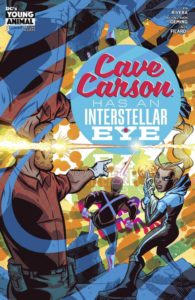 foreshadowing of Quinn’s current, more independent status sprinkled in with the humor and action; if you miss those Batman Adventures/Batman and Robin Adventures/Gotham Adventures comics (or the TV cartoons that inspired them), you should like this a lot. Batman itself concludes a three-parter about Booster Gold changing the timeline by keeping young Bruce Wayne’s parents from dying — which, of course, leads to many bad things; as long as you don’t mind Booster being an idiot, it’s a lot of grim fun, and a way to while away the Bat-time until the wedding. Cave Carson continues to be readable because of its cheerful, everything-but-the-kitchen-sink story approach, with Michael Avon Oeming’s art
foreshadowing of Quinn’s current, more independent status sprinkled in with the humor and action; if you miss those Batman Adventures/Batman and Robin Adventures/Gotham Adventures comics (or the TV cartoons that inspired them), you should like this a lot. Batman itself concludes a three-parter about Booster Gold changing the timeline by keeping young Bruce Wayne’s parents from dying — which, of course, leads to many bad things; as long as you don’t mind Booster being an idiot, it’s a lot of grim fun, and a way to while away the Bat-time until the wedding. Cave Carson continues to be readable because of its cheerful, everything-but-the-kitchen-sink story approach, with Michael Avon Oeming’s art 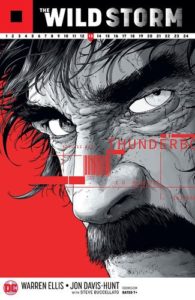 capable of being both chaotic and clear, funny and serious, and so exactly the right style; it’s too bad that this isn’t an ongoing series, but, like any rich meal, it’s probably best sampled in moderation. That leaves The Wild Storm, beginning the second year of Warren Ellis’s reimagining of the Wildstorm universe, with Stormwatch and IO squaring off in a fight that might break the world, and a new take on Marc Slayton and his Backlash character; that kind of deep dive into past continuity, while altering it to make it stranger, more coherent and more fascinating, is exactly what Ellis does, and why he’s proved such a good choice for this long-form renovation project.
capable of being both chaotic and clear, funny and serious, and so exactly the right style; it’s too bad that this isn’t an ongoing series, but, like any rich meal, it’s probably best sampled in moderation. That leaves The Wild Storm, beginning the second year of Warren Ellis’s reimagining of the Wildstorm universe, with Stormwatch and IO squaring off in a fight that might break the world, and a new take on Marc Slayton and his Backlash character; that kind of deep dive into past continuity, while altering it to make it stranger, more coherent and more fascinating, is exactly what Ellis does, and why he’s proved such a good choice for this long-form renovation project.



